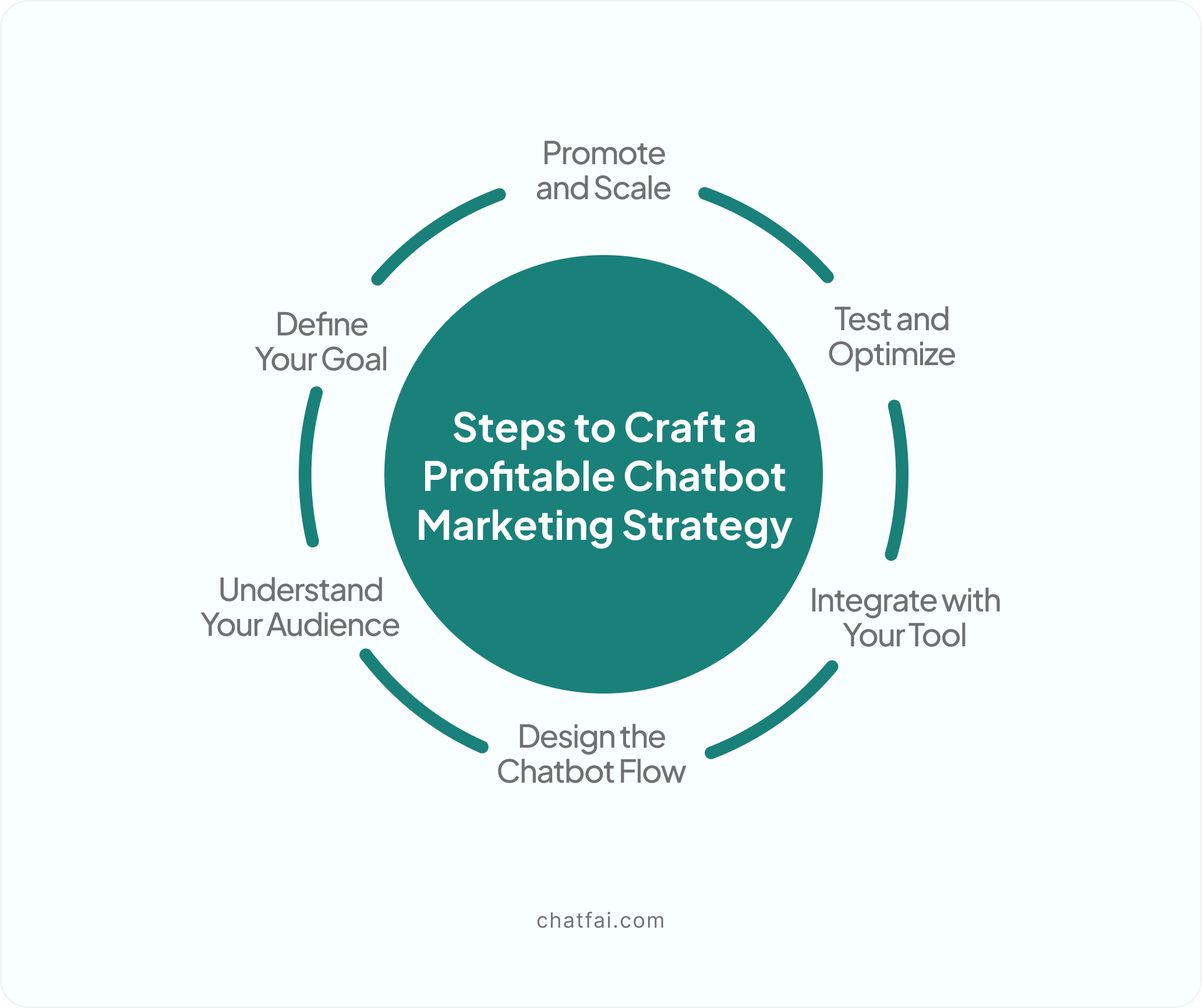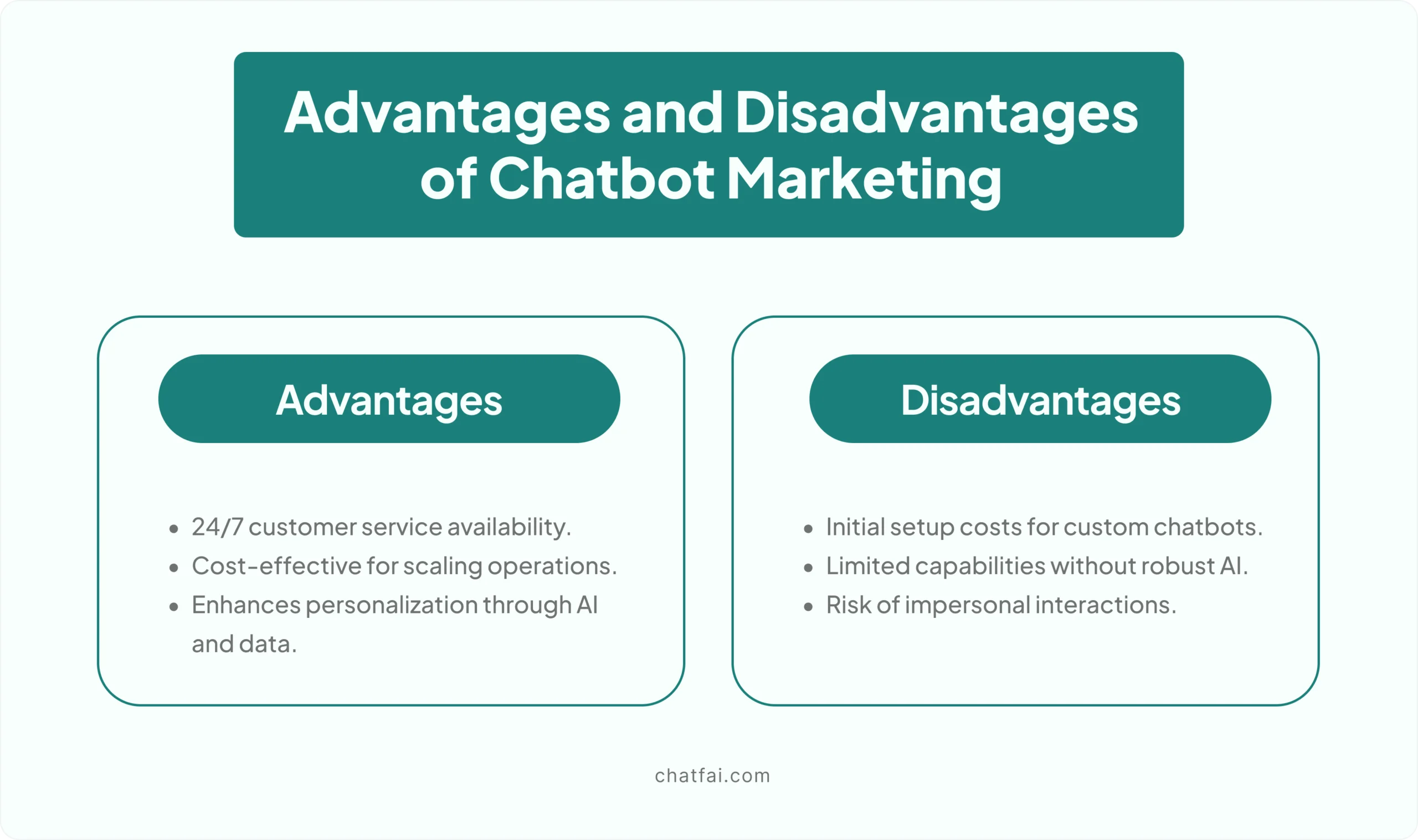Imagine your potential customer is browsing your website at 3am, looking for answers. No one’s awake on your team, but your chatbot is. It greets them, answers their questions, and even convinces them to make a purchase, all without breaking a sweat.
Chatbots are a game-changer for businesses. They can work 24/7, handle hundreds of customers simultaneously, and give you more time to focus on growing your business. But having a chatbot isn’t enough. To truly make an impact, you need a solid strategy.
So, how do you turn a chatbot into a money-making machine? How do you ensure it doesn’t just sit there collecting dust but helps your business grow? This blog will highlight how to craft an effective chatbot marketing strategy.
So let’s get started!
Understanding Chatbot Marketing
Before crafting a chatbot marketing strategy, let’s first understand what chatbot marketing is.
Businesses have been using Chatbots to provide customers a seamless and hassle-free experience. If you ask me how chatbots increase sales, then here’s the answer:
Chatbots help potential customers throughout their buying journey, from engaging with them to helping them decide which product to buy.
Since chatbots play an integral part in increasing revenue, a chatbot marketing strategy is necessary. But chatbot marketing isn’t just about automating tasks. It’s about using technology to build connections, solve problems, and create a seamless experience for your audience.
With the right approach, it becomes a powerful tool to boost engagement and save time.
Easy Steps To Craft Your Chatbot Marketing Strategy
To successfully do chatbot branding, it’s necessary to craft an effective marketing strategy. Here are the steps to make the best chatbot marketing strategy:

1. Define Your Goals
What do you want your chatbot to do? Think of it as setting the GPS for your strategy. Do you want it to:
- Generate leads?
- Help customers and visitors with quick answers?
- Boost conversion rates?
- Spread the word about your brand.
Be clear about your goals. They’ll shape everything—from how your chatbot interacts to what features it offers.
2. Know Your Audience
Who will your chatbot be chatting with? Take time to understand:
- Who they are (age, location, preferences).
- What they need (common questions, problems they face).
- How do they communicate (formal, casual, emojis, or no emojis?)?
The better you know your audience, the more helpful and relatable your chatbot can be.
3. Pick the Perfect Spot
Where will your chatbot live? Think about where your audience hangs out the most. Some popular options are:
- Websites with chatbots are great for answering FAQs or assisting during purchases.
- Messaging apps like Facebook Messenger, WhatsApp, or Slack are fantastic for real-time conversations.
Choosing the right platform ensures your chatbot is in the right place at the right time, ready to help your audience.
With these basics in place, creating a chatbot marketing strategy is easy. Scroll down to learn how to make a chatbot business profitable using a bot marketing strategy.
4. Develop Your Chatbot
Start by choosing how you’ll develop your chatbot. If you’re tech-savvy, you can build it yourself or use a no-code/low-code platform to save time and effort. However, it’d be a great hassle.
With ChatFAI, you can create your chatbot using API. To do this, head to the “Developers” option on the website. Click on “API documentation” to get assistance.

5. Define Conversation Flow
Creating a custom chatbot is one thing, and training it is another. The next step would be to design your chatbot’s conversational flow. This is where the magic happens:
- Plan how your chatbot will greet the user
- Answer common questions
- Guide them through complex interactions.
A well-thought-out flow ensures that conversations feel smooth and intuitive, like chatting with a helpful human.
6. Create Engaging Content
Start by filling your chatbot with valuable and relevant information. Use resources like FAQs, knowledge bases, and customer feedback to ensure it has accurate answers and helpful solutions. The goal is to offer real value—solve problems, answer questions, and make the user’s experience seamless.
7. Test and Optimize
You might be looking for the answer: how do I publish a chatbot? Before launching your chatbot, test it thoroughly to spot any glitches or weak spots in its conversations. This is how you make a chatbot successful.
Check how well it handles different scenarios and ensure the flow feels natural. Once the chatbot is live, keep refining it by gathering user feedback and tracking its performance.
8. Integrate with Other Channels
For a seamless experience, connect your chatbot to other marketing channels, like your website, social media, or email. This makes it easy for customers to interact with your brand no matter where they find you.
9. Learn and Improve
Your chatbot isn’t a one-and-done project. Use insights from data and customer interactions to improve your chatbot over time. The more you improve, the more value your chatbot will bring to your business.
Sephora’s Chatbot Marketing Strategy
We might lose count if you ask how many brands use chatbots because they have become more common nowadays.
Sephora was ahead of the game in 2016 when it launched a chatbot on Kik, a messaging app popular with teens. The goal? To connect with younger customers who were comfortable with instant messaging.
The strategy worked brilliantly—users sent an average of ten daily messages, engaging directly with Sephora for makeup tips, tutorials, and personalized advice.
The chatbot offered more than chat as it became a virtual assistant for beauty. Users could instantly access video clips, tutorials, and product recommendations. It even helped shoppers in-store by providing quick reviews and ratings or guiding them to popular products.
This seamless, interactive experience enhanced customer satisfaction and boosted Sephora’s accessibility, making beauty shopping smarter and easier.
But here is the caution: not all companies can use chatbots for marketing. Lucky you if your business falls in this category:
E-commerce
Medicine
Hospitality
Banking
Food tech (e.g., delivery services)
Travel
Human resources
Education tech
Auto
Real estate
Logistics
If your industry isn’t on the list, it doesn’t necessarily mean chatbots won’t work for you. The key is to research what can help your customers first.
Another Interesting Read: Benefits of AI chatbots for businesses
Advantages and Disadvantages of Chatbot Marketing
A chatbot can improve your website’s accessibility and revenue, but it has certain limitations because it is not human. Here are the top advantages and disadvantages of AI chatbots in business.

Conclusion
That’s all you need to know about crafting a profitable chatbot marketing strategy. Careful planning before designing a chatbot would be a great help. So make sure you spend enough time learning about different types of chatbots and which one will best suit your business. Only this way can you provide a seamless experience to your clients.
Head to the ChatFAI chatbot to get help in devising a profitable marketing strategy. You can create expert chatbots and complete the brainstorming process. Not only this, ChatFAI can help with testing, optimizing, and developing a chatbot.
FAQs
How to market a chatbot?
Here are the key steps to market a chatbot:
- Define Your Goal
- Understand Your Audience
- Design the Chatbot Flow
- Integrate with Your Tool
- Test and Optimize
- Promote and Scale
How do I sell my chatbot?
To sell your chatbot, consider different business models and see which works best for you.
Is a chatbot a marketing tool?
Yes, chatbots are great marketing tools for automating interactions and enhancing sales. Businesses benefit from 24/7 customer service, data-driven personalization, and closer customer engagement.
How do you encourage users to use chatbots?
Make it as easy as possible for customers to use your chatbot. Add helpful features like a simple menu or speech recognition. Also, think about how the chatbot will start a conversation. Ensure it doesn’t interrupt or get in the way of what the customer does.